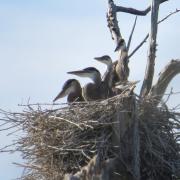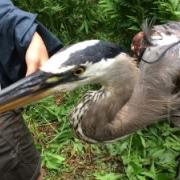Exploring Our School's Very Own Heronry
On October 9th, our Environmental Studies class at Nokomis Regional High was fortunate enough to have wildlife biologist, Danielle D’Auria, come to our class and talk to us about the Great Blue Heron nests that are located on our school grounds. We took a trip to the Heron Rookery right on our school property, where we were able to tag and measure 33 nesting trees and identify 39 heron nests.

Volunteers Contribute a Decade to Heron Monitoring
In what felt like a blink of an eye, we finished up our tenth year of monitoring great blue heron colonies with the help of Heron Observation Network volunteers. These citizen scientists often braved mosquitoes and black flies and hiked through thick swampy forests to get a good view of great blue heron nests, which were often in snags in the middle of a wetland, sometimes in what felt like the middle of nowhere.
Heron Observation Network's Ninth Year in a Nutshell
Volunteers are Vital From Eagle Lake to Milbridge to Eliot, the Heron Observation Network of Maine completed its ninth year of monitoring great blue heron colonies in an ongoing effort to better understand the status of the population. Great blue herons are widespread throughout Maine; however, a noticeable decline in their coastal nesting population has occurred since the 1980s.

Meet Our Most Highly Pursued High-Tech Wader: Snark
Have you heard about “Snark,” the first great blue heron in Maine to be outfitted with a GPS transmitter last spring, and the only one to be recaptured a year later? The great blue heron is a Species of Special Concern in Maine due to a decline along the coast.
Volunteers Essential for Keeping an Eye on Maine's Herons
Now that winter has finally decided to show up in Maine, I figured I should report on our 2016 field season before the 2017 season is knocking at our door. I guess it takes a blizzard to get me to stay put long enough to enter and analyze the past year’s volunteer monitoring data! The Heron Observation Network’s volunteers have been monitoring great blue heron colonies across Maine for eight years now, and this past year’s effort was just as important as the first year of monitoring.
Tracking Maine's Great Blue Herons - Online!
This spring, MDIFW tagged five adult great blue herons with GPS transmitters as part of an ongoing effort to better understand the state’s great blue heron population. After a significant decline in the number of nesting pairs on Maine’s coastal islands from the 1980s to 2007, MDIFW listed the great blue heron as a Species of Special Concern and began a citizen science adopt-a-colony program called the Heron Observation Network.
Photos From 2015
This video is a showcase of photos taken by volunteers and staff throughout the 2015 colony monitoring season. It is 9 minutes long, complete with music, captions, and photo credits. Thank you to everyone who shared your magnificent photos for inclusion. Think Spring!
HERON Volunteers Fill Crucial Information Gaps
[caption id="attachment_1318" align="aligncenter" width="1024"] Great blue heron nest discovered and photographed by Paul Cyr.[/caption] This past spring while I was focused on completing an extensive aerial survey effort to estimate the statewide breeding population of great b
Nature’s Beauty Inspires Linda Panzera’s Photographs and her Generosity to Maine’s Wildlife
[caption id="attachment_1309" align="alignleft" width="225"] HERON volunteer, Linda Panzera, with camera in hand while observing a great blue heron colony.[/caption] One of the best aspects about running a citizen science program such as the Heron Observati
On the Hunt for Heron Foraging Locations
[caption id="attachment_1277" align="aligncenter" width="879"] Photo series by Doug Albert.[/caption] We are looking for volunteers willing to scope out areas habitually used by foraging great blue herons in anticipation of a potential research project aimed at tracking adults with satellite transmitters. By partnering w
Keep In Touch!
Enter your email or mobile number to receive the latest news from MDIFW.